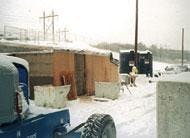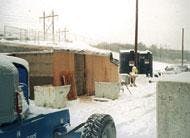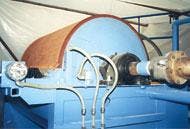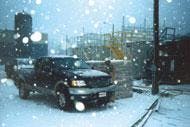In early 2000, Phil Manning, Startup Manager of GE International Power Systems in Westbrook, ME, had just completed construction on a 525 megawatt gas-fired combined-cycle power plant. Manning was facing an environmental issue that required specialized expertise: how to properly dispose of wastewater generated during the boiler cleaning phase.
Manning called on Quality Environmental Technologies (QET) to provide a system that would treat the wastewater so that it could be safely discharged into the local sewer system. QET provides turnkey environmental waste management resource recovery solutions, design, construction, consulting services, and environmental engineering capabilities to aerospace, automotive, power plant, manufacturing and public utility industries.
Proper boiler cleaning and passivation is a critical step toward successful boiler startup, operation, and long-term equipment performance.
"Before placing industrial boilers on line, they require operational cleaning, corrosion prevention, or passivation," said Arnie Owsley, President of QET. "Cleaning removes significant amounts of weld slag, dirt, oils, and grease within the boiler that result from manufacturing and assembly. If not removed, this slag prevents proper operation of the boiler and contaminates water introduced into the boiler during operation. Passivation seals the boilers and prevents corrosion caused by alloy metals leaching from the materials used to construct the boilers.
"Although a variety of cleaning methods exist, each method must be assessed to determine which will best meet the customer's criteria and provide a positive outcome."
There are three basic cleaning methods: air blowing, steam blowing, and chemical cleaning.
Air blowing forces large quantities of compressed air through the boiler to remove surface impurities. Steam blowing pushes steam through the boiler and boiler piping, causing contaminants to be dislodged from the surfaces of the boiler. The steam is then released, along with dislodged contaminants, into the air.
The third method, chemical cleaning, was chosen by GE and done by a chemical cleaning contractor before QET's arrival at the Westbrook site. Said QET Project Manager Andy Getz, "only chemical cleaning would yield the results GE demanded."
"GE used a two-pronged approach," Getz said. "They chose to chemically clean the boilers, and contracted us to treat the resulting wastewater to a purity that would enable GE, with the appropriate permits, to discharge it down local sewer lines. The goal of treatment was to meet the required pretreatment limits of the receiving Wastewater Treatment Plant (WWTP). This was not only the most environmentally responsible option; it was also the most cost-effective. If we treated the wastewater on-site, we could eliminate a significant cost that GE would incur if the wastewater had to be hauled to an off-site industrial treatment facility."
QET knew how important it was to GE that the disposal method be environmentally friendly. Said Manning, "I wanted QET to be involved in this project because of their success in the area of wastewater pretreatment."
Boiler Cleaning
Although chemical cleaning is a multi-phase process, turn-around time is extremely fast. During phase I cleaning, the chemical cleaning contractor introduced a combination of surfactants and ammonia into the boiler, raising the pH to approximately 13. This combination of chemicals and pH was used to remove slag and other contaminants from boiler walls and piping. Without draining the boiler, phase II chemicals were added to inhibit corrosion of the newly cleaned boiler system by treating it with a solution of citric acid, dropping the pH to 1.
In phase III, the pH was returned to approximately 9.5, and an ammonia and sodium nitrate passivator was added to the boiler system to seal boiler surfaces and prevent leaching of metals from the boiler system to the water. To complete phase III cleaning, the system was completely drained, then filled and drained twice more with rinse water.
With 690,000 gallons of wastewater remaining, QET began the next phase of the plan – wastewater pretreatment.
Wastewater Treatment
"We were in the middle of a rough New England winter, with sub-zero temperatures and snow everywhere," Getz said. "We constructed a temporary structure to house the rotary drum vacuum unit and began recycle activity."
Coagulants were introduced into the wastewater to destabilize colloidal solids into particulates, break down oil and water emulsions, and as a preparatory to flocculation. Flocculants were then added to accelerate solids settling rate, increase solid density, and facilitate mechanical solids dewatering. Impurities were processed and separated from the wastewater by a rotary drum vacuum pre-coated with diatomaceous earth (DE).
QET staff worked 24/7 to transform 690,000 of wastewater into clean, recyclable water.
Test and flush
The primary concern to an industrial WWTP are ammonia and metals. Pre-cleaned process wastewater can contain high metal, dissolved and suspended solids, and elevated ammonia concentrations in excess of those permitted by the site's effluent discharge permit (i.e. typical National Pollution Discharge and Elimination System [NPDES] pretreatment permit limits).
High concentrations of ammonia are toxic to the treatment plant's biological processes. Suspended solids must be removed and require disposal at a cost to the WWTP.
High levels of metal could potentially cause the WWTP to exceed its metals discharge limit or the disposal limits imposed on its waste sludge. Iron and total dissolved solids (TDS) are not usually of significant concern to WWTP.
Preliminary sampling was done using a certified environmental laboratory. Toxicity Characteristic Leaching Procedure/Resource Conservation and Recovery Act (TCLP/RCRA) metals were sampled to ensure that the DE filter material could go to a construction landfill as a non-hazardous waste. Wastewater filtrate was taken before and after dewatering.
All samples were analyzed for the same metals, which gave concentrations of any metal (ppm of lead, copper, chrome, etc.). Ammonia concentrations were taken and measured in parts per million (PPM). The pH was also determined for all samples. This enabled QET to adjust the pH levels as necessary for discharge. Conductivity was taken to determine the level of dissolved solids in water.
The test results of the process pretreatment water pleased Manning.
"The results showed that the processed wastewater met purity criteria and was at or below typical industry limits with iron removal efficiencies at 99%. With approval from local environmental regulatory authorities and the WWTP, QET processed 690,000 gallons of metal cleaning wastes on-site into a filtrate clean enough to be discharged into the sewer at the municipal water treatment facility," Manning said.





